THE SIBERIAN CAT -The history of love and public recognition.
By Dr. Irina Sadovnikova, WCF Int. All Breed Judge.
Special updated version 2008, with a P.S.
(Reprinted with permission)
This article was written in 2004, published in a Russian cat fancy magazine and after that, translated into several languages, on the Internet. However, some changes had to be made, as life goes on and new developments happen. The recognition of the full color palette of the Siberian cat in CFA was one of them, so the text was slightly changed. I also added a simpler description of the face. But the text also needed postscripts, featuring my thoughts caused by reading recent publications.
The Siberian Cat is one of the most mysterious beings created by human and Nature. Having written this phrase I imagine the reader perplexedly shrugging his shoulders, thinking: what can be mysterious about a Siberian Cat? It would be quite strange even to call it a pedigreed one. Other breeds attract people by their exotic names and unusual appearance - Sphynx, Somali, Cornish Rex... We hear the music of distant wanderings in these names. The proud owners standing behind the cage at the show never hear the words of the kind that each of us, owners of the Siberian Cats, has at least once heard: "Look, this pretty cat looks exactly like our Murka!" Or even: "We have seen such a cat in our yard". But nevertheless... I doubt that any other breed has gone a way from complete obscurity to international public recognition in such a short period of time. I also doubt that any other breed has ever stirred up so many disputes in its native country. Both the origin and many characteristics of the Siberian Cat are treated by felinologists ambiguously.
A large number of works has been written about the Siberian Cat. I would neither like to recur to all of them, nor to pour oil on the dying flames of the dispute. So I will try to speak in more detail about the facts that are not known to the reader or that have been interpreted in a way different from the one we are used to here, in Saint-Petersburg; A little about the origin of the breed; The work that has been done to create its modern appearance; Some breeding problems; International recognition.
A glimpse at history
Beautiful stories are told about the origin of different cat breeds. The Sacred Birman, probably created in France by means of crossbreeding, had received a charming name and a legend about the cats of Eastern temples bound up with it. The Norwegian Forest Cats, originated from aboriginal Scandinavian semi-longhair cats, according to the legend were the charioteers of the goddess Freya. The Maine Coon, a similar semi-longhair cat from the shores of North America, is said to be an offspring of a wild cat and a raccoon. There are also some legends about the Siberian Cats. For example, the one that says they had originated from wild forest cats in the snowy dense forests of taiga and in the Middle Ages guarded the monasteries in Siberia. And it is no wonder - if the history of the Maine Coon can be traced since the 80's of the 19th century and that of the Norwegian Cat - since the 30's of the 20th century, then the written history of the Siberian Cat appears much later. But the name "Siberian Cat" has a really long history in spoken language.
Let us digress for a while from today's appearance of the Siberian Cat, very well known to cat judges and many other cat fanciers. Let us go back to our childhood and try to remember. If we had been asked what a Siberian Cat was and what it had been like, most of us would not have said anything but "fluffy". Someone may have added "large". By method of exclusion we can add "not white" - as all white fluffy cats had been called Angora. But it is for sure that nobody would have characterized this cat as "the one that lives in Siberia".
Dog breeds were quite well known. Cat breeds - rather vague. All cats of the Siamese color were called Siamese. They also spoke of the so-called jungle-cat - if the animal was too wild-tempered. Other "names" of breeds and other ideas about their appearance occurred in some areas. In one village, a home of my friends, all grey short-haired cats with stripes were called rat-catchers and even were selected according to their hunting skills, ostensibly connected with their color. O.S. Mironova mentions the name "Bukhara", used in some Siberian regions for these fluffy cats. Popular conceptions of the Siberian Cat are based on the idea of an animal able to withstand the severe Siberian climate, rather than on its actual origin. "Siberian frosts" is another word collocation which has lost its direct connection with the territory.
The mystery of the origin of the Siberian Cat is mainly connected with the fact that speaking of its history we confuse three different notions: the modern Siberian Cat (a breed with its standard and unique appearance), the popular notion "Siberian Cat" (tracing its roots back in remote ages and being a linguistic rather than feline phenomenon) and the aboriginal semi-longhair cat living on the territory of Russia since the ancient times.
Speaking of the latter, the ways these cats got into Russia and moved further to the North and the East are historical trade routes, such as the one from the Varangian to Greek and the Great Silk road. It is quite possible that the Angora, the Siberian and the Persian had the same ancestors, newcomers from Asia Minor. It is also possible that sometimes they would cross with the wild steppe and forest cats. But it is a mere supposition. Documentary records about cats in Russia are poor; they do not describe these animals. They mention colors of cats, grey cats, but unfortunately not fluffy ones. And later on, when naturalists travel round this country, they pay attention only to the colors. Brehm writes about "a breed of red cats" he noticed in Tobolsk, and Pallas gives a full description and a colored print of a rather sturdy colourpoint cat, one of the three animals of this kind from the litter of a black queen and an unknown sire he saw in the province of Penza. These records are not more than proofs of the existence of cats on the territory of Russia and presence of certain color genes in their gene pool, but not milestones in the history of the Siberian Cat.
* Comments on the latest research on the origin of the domestic cat see in part 3 of P.S.
Creation and development of the breed.
So what is the history of the Siberian Cat as a breed, not just as a semi-longhair cat that lived in Russia? Its beginning dates back to the 80's of the 20th century. It can not be expounded without remembering the first years of the Russian cat fancy.
The Soviet and the Russian cat fancy originated in such large cities as Riga, Moscow and Leningrad. Riga bears no relation to Russia; I mention it here only because this city was the first in the USSR to create a club and to hold a cat show. After that a show was held in Moscow, then in Leningrad. It is quite natural that crowds of cat fanciers with their pets poured into the first clubs. Cat books with colorful pictures had appeared long before and each cat owner examined his pet to find the features resembling these pictures and romantic descriptions. I still remember how desperately I wanted my first cat to be called Norwegian, because I had read in a quite serious book that only these cats climb down the trees like squirrels, head first. My kitty really did so climbing down a pine at our country house! But when I brought my green-eyed torbie, grown up from a dirty dag found in the back-yard of the tire factory, to the club, they said it was a Siberian Cat. (They would also find "Maine Coons", "Norwegians" and "Balinese" cats in those yards and near rubbish cans... However, most of these cats had never managed to overcome the hurdle of the Novice class. Some remained household pets; some were accepted as Siberian Cats by the judges).
* Look for update on "Balinese" in P.S. below (Part 5).
At that time the idea to create a Russian breed was up in the air. And of course it should have been called "Siberian Cat", due to the long history of this word collocation. But the appearance of this cat had not been obvious yet. It must have been semi-longhair, but what else? Type, size, shape of the head, muzzle contours, placement of ears - a wide variety of these features was represented in the urban and the suburban population of semi-longhair cats (let us call them "conventionally aboriginal") studied by felinologists. They had to make choice on the basis of the predominant type in the population, taking into account already recognized breeds of semi-longhair cats, mainly the Maine Coon and the Norwegian Forest Cat. Everybody wanted to refrain from the repetition of the existing things.
** Look for update on "archetype" in P.S. below (Part 2).
The first standards of the new breed were created in the late 80's by the felinologists of the "Kotofei" club (O.S. Mironova, I.J. Katser, etc.). At the same time the Siberian cats were registered and bred by other Russian felinologists. In Moscow this work was being done by T.S. Emelyanova, L.K. Ovchinnikova, T.D. Sapozhnikova. But it was "Kotofei" that wrote the standard. The legendary Siberian stud Roman, born in 1987 (owner A. Ivanova, "Kotofei"), was taken as a model. He was one of the foundation cats for the breed.
*** Look for update on the first Russian felinologists in P.S. below (Part 4).
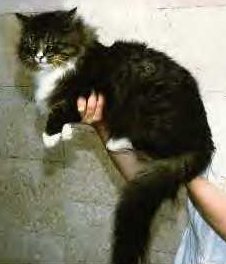
Since the very beginning the following features have been emphasized: powerful type, solid bone structure, round paws, full rounded muzzle, ears set wide apart and oval eyes. The shape of the head was specified as rounded. The size was slightly exaggerated by the standard. If the text of the 1989 standard resembles a romantic description, then the standard of 1990, keeping almost the same body parts also includes the colors (agouti, agouti with white, non-agouti, non-agouti with white and colourpoint in the same groups) and the faults.
The SFF, which at that time was called the Soviet Felinology Federation, accepted this standard. In 1991 the first international standard was worked out on its basis. The WCF, being a young international federation at that moment, was the first to admit the Siberian Cat, including the Siberian colourpoint. Another famous foundation male, Mars, a blue tabby point with white, born in 1988, belonged to "Kotofei" too.
Mars and his son Nestor can be found on hundreds of pedigrees. Nestor is a founder of the bloodline of the "Gel" cattery. His blood was also used in the "Marcell" cattery in combination with Roman's line (which later turned into the lines of Vergiliy and Lucreciy). "Kotofei" has also brought up other foundation cats later used in new clubs.
I have the yellowed catalogues (mainly in the course of time, but some - with the help of cats) of the first cat shows in front of me. Let us try to find Siberian cats there. Before 1991 the owners entered them into various breeds and groups:
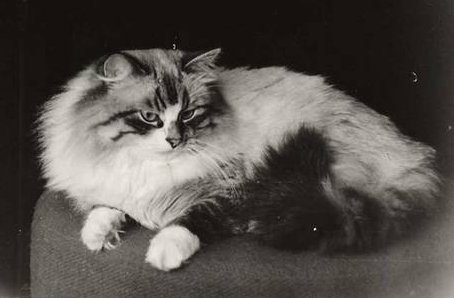
1989: Moscow, May 8-9.
The first All-Union cat show. 190 animals in the catalogue, good few are Persian. The section "Longhair and semi-longhair cats of unknown breeds" includes 12 Siberian Cats. All of them have no registered parents. However the section "Household cats" is more extensive. We see here Mars for the first time, on the supplementary list. He enters the Novice class as a Siberian Cat at his next show and becomes a stud.
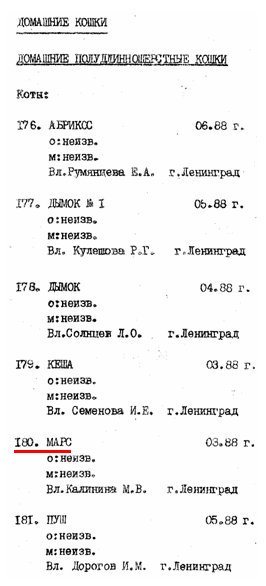
1989: Riga, September 23-24.
164 cats in the catalogue and again almost half of them are Persian. The section "Officially non-recognized breeds" includes the Siberian and the Neva Masquerade. Number 146 in the Novice class is the famous Roman. In the Open class we see the former novice seal point Ricky, who later gave birth to many offspring together with Selina. And Selina appears in the Novice class as... Balinese! She is transferred to the Siberian breed at this show. Many pets go through this way if they start in the Novice class.
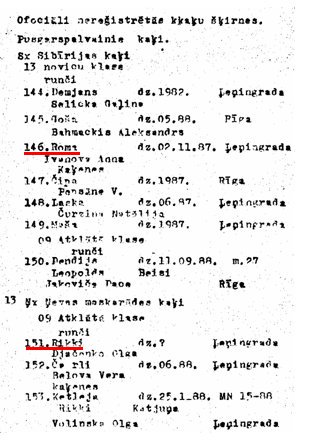
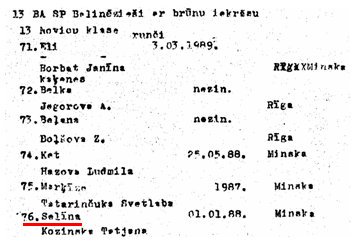
1989: Moscow, September 7-8.
244 cats in the catalogue. The Siberians are included as a breed group, there are 26 of them. Cats from Leningrad are simply not included into the catalogue at this show. But then we can trace the destiny of the "Balinese" male Boyz, born in 1988, who had been found with his elderly mother and sister of the same color in Samara by Irina Gorinova. Boyz, who had also been transferred to the Siberian breed, was successfully shown later, and lived a long life.
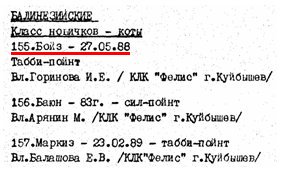
On the 16th of September 1989 a group of breeders from Leningrad and Moscow applied for the registration of the Siberian Cat to the SFF, established in April of the same year. The breed is registered on August 6, 1990 (Certificate №1). At the same time the colourpoint Siberian Cat is registered as a unique color variety of the Siberian with a second name "Neva Masquerade" (Certificate №2). Now the show catalogues of the clubs cooperating with SFF should include the Siberian Cats in the semi-longhair section with a separate group of colors "Siberian Colourpoint (Neva Masquerade)".
The show of the "Kotofei" club, January 5-6, 1991. 342 cats in the catalogue. 119 Siberians, including 29 colourpoints. The Novice class includes 50 Siberians, with 13 colourpoints. The eldest cat is nearly 10 years old, but she is shown in the Novice class. There are lots of animals of the first generation with birth certificates (no pedigree certificates yet: to get a pedigree certificate instead of the birth certificate, first generation progeny should have been evaluated by judges). Offspring of Roman, Mars and dozens of other former novices.
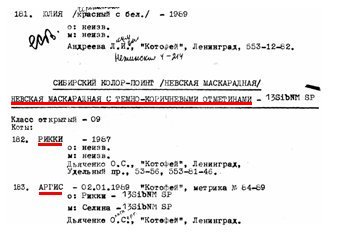
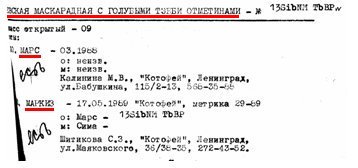
Despite the ample quantity of pedigree material, the stock of the early 90s had much to be desired. The litters "fell to pieces". Only devotees dealt with the Siberians... Many clubs and even judges sneered speaking about them. But at the same time the interest to the Siberians abroad grew in leaps and bounds. If the animals which had earlier been exported to East Germany and Czechoslovakia were those "popular" Siberian cats without any standards or documents (by the way, they are the founders of some European lines of insufficient type), then the export of the early 90's consisted of the first and the second generations of the Siberians, the results of breeding. The offspring of Roman were imported to the USA by Elizabeth Terrell of the "Starpoint" cattery.
The "Starpoint" lines are still highly valued in the US.
A considerable quantity of cats of different colors was imported to Germany by Hans and Betty Schultz (the "Newskij's" cattery), who played a great part in the popularization of the breed in Europe. Newskij's Magadan Terranka, a male bred in this cattery, could compete at shows even nowadays. But still, the first wave of the exported Siberians was on the whole of poor quality. It resulted in the situation, when each breeder or cattery owner tried to create his own standard for his stock. At that time some foreign judges thought that the Siberian Cat is not more than a poor type Maine Coon. Or even a cross of the Norwegian and the Maine Coon. All these breeds have a similar coat structure with slight differences; they all are quite large and sturdy. It was not a simple task to find distinctions in their size, length of the legs and of the tail, and shape of the head stated in the first standards. Although the draft standard of the WCF in 1990 was based on the one by "Kotofei", in 1991 the first official standard underwent some changes: high cheekbones were mysteriously added to the rounded shape of the head and the tail was to be long to very long - it indeed resembled a poor Maine Coon. Especially taking into account the fact that it was very difficult to find ideal representatives of both breeds in Europe.
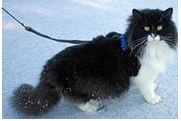 |
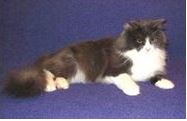 |
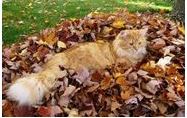 |
| Lundberg Zorro | Windrifter Larisa | Birchgrove Toyla Taigovich |
The distinctive features of the Siberian Cat had to be emphasized in the standard to win the public recognition. These characteristics had to be found and fixed in the breed to create a unique appearance. The stress was made on the head shape. Broad low cheekbones connected by a gentle line to a rounded muzzle could not be confused with a head of the Maine Coon or the Norwegian Forest Cat. For the first time these features were described in the Leningrad/Saint-Petersburg stock and included into standard by PFS (I. A. Okulov, E. J. Dmitrieva) in 1991.
A large group of females had been selected (for example Frazy, Roman's granddaughter, Gladys, daughter of Mars, Pyshka born in 1988, who later became one of the first Siberian cats - World Champions) and two males, the closest to the demands of the new standard (one of them is Georgiy, born in 1987, used to found the "Knyaz Gvidon" cattery).
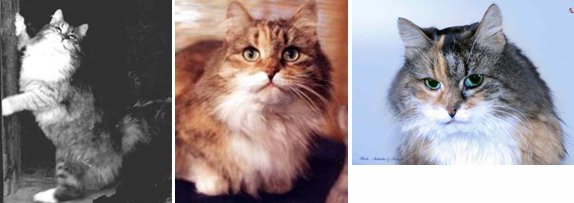
However, these males did not show prepotency. But the idea was followed by luck: a new foundling appeared in the club, a cat "in a poke". An old lady has brought her pet in a bag! It was the male Max, born in 1989, a large powerful cat of seal tabby point color with almost ideal contours of the head and nearly perfect coat, just a little too short. He was the one who proved to be prepotent. So prepotent, that up to the present moment his female offspring in the third and fourth generation give birth to his little copies of all recognized colors.
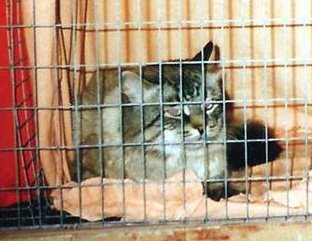
His line, began by the "Nightingale" cattery, is continued by the catteries "Dikaya Krassa" and "Dom Filina". We can already speak about the success of his sons' (W.Ch. Arsenij Nevski and Gr. I. Ch. Filimon) lines. This head shape was soon included into the WCF standard.
In 1994 at the IFSJ seminar the same cheekbone and muzzle contours were used in the composition of a more detailed standard than the PFS one. The shape of the head was specified as "trapeze". This standard was published in the collection of standards of aboriginal breeds, at present it is valid in the SFF and has no significant distinctions from the today's WCF standard. We find "short broad trapeze" in the SFF standard, "short and broad head" in the WCF standard, the cheekbone and muzzle contours have the same description. The length of the tail is set according to the heavy type of the animal: "medium" in the SFF standard, "to the shoulder-blade" in the WCF standard.
The further breeding of the Siberian Cat in Russia is described in detail in many publications. The creation of the Union of Siberian Cats' Fanciers in Moscow (late T.E. Pavlova) has contributed to the popularization of this breed in many respects. This union successfully holds monobreed shows and keeps a record of those Siberians who became World Champions.
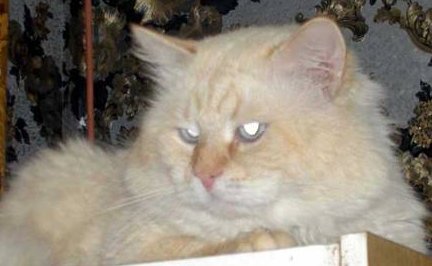
It is not that easy to get cats of a good modern type. If the work on the type is based on line breeding, the cats within one cattery will soon be of the same type with not only merits, but also faults fixed. The exchange of the breeding material between Russian catteries is still insufficient. And if it does take place, then mainly for the purpose of adding a new color or "diluting" the inbreeding. Each cattery is satisfied with its type, which is justified in many respects. Fortunately the poor type elongated Siberians are gradually becoming things of the past. Many catteries achieve great success in body conformation. Large, heavy animals with powerful legs and big round paws can be seen much more often now. Besides that such attractive colors as golden and silver were obtained and fixed.
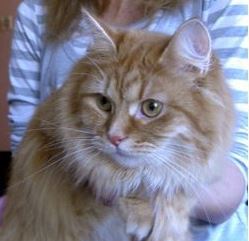 |
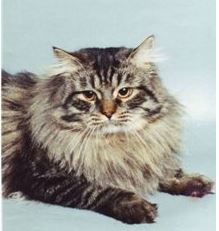 |
| Olisia Laskovy Zver' | Bay Sultan Laskoviy Zver' |
The most problematic moments are the coat quality and the shape of the head. As to the latter, if we put aside long narrow heads, pointed or narrow muzzles which do not comply with the standard at all, then the most difficult task is to achieve the right shape owing not to soft tissues, but to bone structure. The standard on purpose accentuates the fact that the roundness of the facial part depends on cheekbone arches and on the full muzzle, but not on full cheeks. This moment is essential to exclude the undesirable type, close to the semi-Persian.

Among these pictures there are two Siberian cats. Can you find them?
Answer at the end of this section!
The main features of the desired and the undesired type of the Siberian Cat:
| Undesired type (too slender) |
Desired type | Undesired type (Half-Persian) |
|
| Head shape, cheekbone outline |  |
 |
 |
| Forehead and profile shape |  |
 |
 |
| Coat texture | Not connected to the slender type |
 |
 |
| Eye aperture |  |
 |
 |
The cheekbone arch of the ideal Siberian Cat extends to the outer ear base, and the one of a cat of the undesirable type - to the mid-ear. The distance between the canine teeth of the Siberian Cat is large; the lower jaw arch between the fangs is nearly straight. The animal of the undesirable type has a sharper arch and the distance between the canines is short. Optically such a head seems rounded due to the full cheeks and the developed soft tissues of the muzzle. The bone structure of the ideal Siberian is easily palpated; even the cheekbones of a cat in full coat are well seen. If we add the difference in the skull height (an ideal Siberian Cat has a lower skull), the shape of the forehead (an ideal Siberian Cat has a smooth dip from the flat skull to the straight broad dorsum of nose, accented by the direction of the hair growth), the coat texture (the cats of the undesirable type have an overdeveloped undercoat and on the contrary, their top coat is too fine) and the shape of the eyes (the upper lid of the Siberian Cat must create an oval shape of the eye), and often lower placement of the ears, then it is easy to withhold the certificate. Of course not all of these features are present at the same time. That is why cheekbones are worth paying attention to.
To put it in short simple terms: the broad face of a Siberian cat is formed by broad low cheekbone arches, well distanced eyes and a broad nose. The full muzzle is formed by a broad lower jaw with a lot of width between the canine teeth and rounded whisker pads. The profile is formed by a flat forehead, raise at eyebrow level, shallow dip at nose bridge, a straight nose, and a rounded chin.
The inclination to get more decorative cats is often characterized by a longer coat, sometimes together with the changes in its texture. Unfortunately too soft coat is frequently met, not only in dilute colors and some lines of colourpoints, but also in black silver and what is even stranger - sometimes in plain black tabby. The position of the judge is of great importance here, namely the preference of the appropriate texture with firm oily top coat to the length and especially to the color and pattern. Taking into account the fact that both color and pattern can be given not more than 5 points, the cat with indistinct pattern or dim color without any faults in the type, shape of the head and coat texture, can virtually win the desirable 98 points. Faults in the coat texture (up to 20 points) are to be more strictly penalized, especially if it is an overdeveloped undercoat or absence of the typical waterproof top coat. It would lead to more strict selection according to the coat texture in the catteries.
The same inclination to decorativeness sometimes results in the eyes too wide open, nearly round. It is better to keep to the golden mean here. The eyes of the Siberian Cat should be set wide apart, they should be rather large, but not round. Deep and close set eyes are just as inappropriate for a Siberian as round, wide open ones.
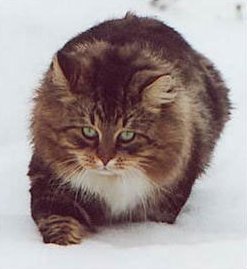
Fiodor Della Niva, Italy
Answer: Cat # 1 is a pedigreed Siberian cat of slender type,
Cat # 3 is a pedigreed Siberian cat of hypertype,
Cats ## 2 and 4 are pedigreed Persian cats of "doll face" type.
Siberians abroad.
In America they had changed the standard in their own way, however, understanding that there should be as many distinctions from similar breeds as possible to win the recognition. It was expressed in the preference of rounded shapes in all the sections of the standard. Head, eyes, belly of an American Siberian should be nearly round, and special attention is paid to the low ear set. On the contrary, the standard does not specify the cheekbones. The best catteries, truth to say, still come to 'our' type of the modern Siberian. Siberian cats have a full championship status in the TICA and the CFA.
In Europe the stock had been very diverse for a long time. Poor type with long legs and tail, elongated muzzle and high cheekbones was quite widespread. They even came to oval paws and absence of undercoat, stating the latter in their "new" standard. But in the recent years the appearance of the Siberian Cat in European countries has become good enough. Reasonable import in combination with well thought-out breeding bears its fruit. And again an interesting trend - despite the distinctions in standards (in the FIFe standard they had a long tail and high cheekbones until 2006) the best cats have our modern appearance.
Unfortunately, both in the USA and in Europe there are catteries keeping to the idea of roundness too closely, where cats look too much like the old traditional Persian. This is a detrimental tendency, as it works against the original idea to select for a cat of unique distinct appearance.
There are very few European countries left where nothing is known about the Siberian Cat. The Siberians have recently come to Great Britain, though this island had been closed for them for some time. Several generations of good Siberians have already been born there. And on September 8th, 2004, we got to know the good news: presentation of the Siberian breed at the meeting of the GCCF Executive Committee got crowned with recognition! The GCCF standard is more detailed than the WCF one, but at the same time it is the analogue of our standard in terms of type and recognized colors.
Now the Siberian Cat can be found in any part of the world, except for Antarctica. There are catteries in Japan, South Africa, South Korea... The Siberian Cat has won the world in a split second and is going to hold its positions.
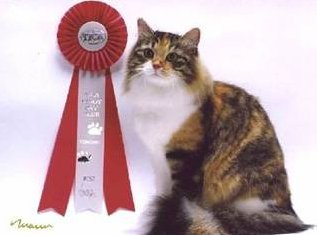 |
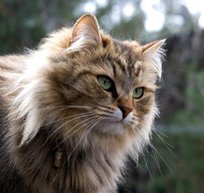 |
P.S. Seven PostScripts
Part 1: Hypoallergenic cats
Another development was screening a group of Siberian cats in the USA for Feld1, a known allergen. In the original text of the magazine article I had a short part devoted to the alleged hypoallergenic qualities of the Siberian cat. At that time we could only quote success stories and hypothesize; now we have a leg to stand on.
Siberian Research Inc., (a not-for-profit association of Siberian breeders) has tested a number of Siberians for Fel-d1 levels in both fur and saliva (http://siberianresearch.org/about-allergens.htm). Results showed many Siberians have lower levels of allergen than other breeds, and offspring from tested low-allergen cats were less likely to cause allergic reactions than offspring from other matings. No correlation was found between colourpoints and allergen levels.
Part 2: Archetype of the Siberian Cat
One more development has been the steady growth of interest in the origins and development of the domestic cat, with interesting articles being published. A most interesting article by Dr. A. Kolesnikov (The Siberian cat - part I-III) often uses the notion "archetype of the Siberian Cat". The word is, in fact, strikingly suitable to talk about the Siberian Cat, as its meanings suggest:
- the original pattern or model from which all things of the same kind are copied or on which they are based; a model or first form; prototype.
- (in Jungian psychology) a collectively inherited unconscious idea, pattern of thought, image, etc., universally present in individual psyches
And in biology:
- a primitive generalized plan of structure deduced from the characters of a natural group of plants or animals and assumed to be the characteristic of the ancestor from which they are all descended
- original ancestor of a group of plants or animals.
In all meanings, obviously, "archetype" is a construct, something that doesn't exist in reality, but may have existed in the past. However, it is only by speculation that we can re-create this archetype. No one has ever been able not only to study the mediaeval remains of domestic cats on the territory of Russia, but also to see a picture, or read a detailed description. The appearance of the Siberian cat has followed an "archetype" in many meanings, and the "Jungian philosophy" one is among the most important of them. As mentioned in the beginning of my article on Siberian history, it had been dictated not only by the type predominant in the urban and suburban population, but also by the general idea of a big frost-resistant cat, and, as regards head shape, by distinct features, vitally important in order not to be confused with already existing breeds. The frequent presence of colourpoints among the original alley cats and pets to be included into foundation Siberians reinforced the distinction idea in colors, too. Quoting Dr. Kolesnikov, "[the first Russian felinologists] captured the breed's archetype features common both for big cities and for Siberian backwoods". He also illustrates his idea of the existence of such archetype by similarities in the phenotype of cats after "a plethora of outcrosses between cats from different locations". I wonder if identical phenotype similarities would be reason enough for the author to agree that descendants of lines bred for type without excluding colourpoints have the same archetype?
A test for unprejudiced readers: please decide which of the males shown in the pictures have multiple colourpoint ancestors? (Answer at the end of article!)
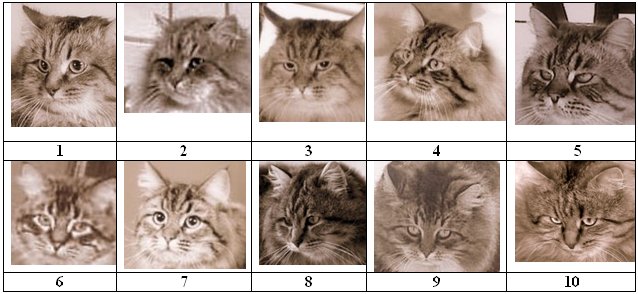
Part 3: Origins of cat breeds
An important milestone in understanding the origin of domestic cats was "The ascent of cat breeds: Genetic evaluations of breeds and worldwide random-bred populations" by Monika J. Lipinski et al. This article, on the one hand, shows the result of genetic analysis that (quote) "clearly delineated four genetic clusters of cats, corresponding to Europe, the Mediterranean basin, East Africa, and Asia".
Interpreting these results, Dr. Kolesnikov stresses that "the most important is that recent molecular genetic analysis unequivocally demonstrated that Siamese clad of cats (in which Thai cats represent one of the archetypes) is genetically most distant from the rest of the cat breeds as well as from European and Mediterranean alley cats [4]. Siberian cats included in that study represent no exception and are located at the opposite branch of this genetic tree". He also attracts the attention of the reader to the fact that Persian cats lost their region-specific genetic features, and are now closer to the Western than the Mediterranean cluster.
On the other hand, the researchers also state:
- that the next separation after that of the South-Eastern cats occurred between the tight cluster of Western European cats and dispersed groups of Mediterranean, North Asian and East African cats;
- that the Siberian cats are genetically close to random populations of Western Europe (ibid). This contradicts the hypothesis about Iran/Caucasus/Siberia as the sole points of origin of the breed.
The quoted article also mentions within-breed heterogeneity of Siberians and states that several breeds have multiple lineages: "Five breeds (British Shorthair, Exotic Shorthair, Norwegian Forest Cat, Persian, and Siberian) showed subdivisions within each breed, indicating multiple lineages". Within-breed heterogeneity of the Siberian stated by the researchers shouldn't actually be surprising taking into account the sheer size of Russia.
Putting aside the artificial breeds, to which the British Shorthair should at present be also counted, we are left with the Norwegian and the Siberian - shouldn't we suppose they are relatives who, incorporating multiple (but probably not identical) regional peculiarities, had gone a long way alongside each other before being separated? And isn't this multiple lineage the reason for genetic diversity, as shown in Fig. 4 of the quoted article - NFO are the second most genetically diverse breed after Siberians? And isn't genetic diversity an asset for breeding? At least, this is what the authors of the article think.
This research didn't involve European Shorthair cats. I have a strong suspicion that in Russia they would show multiple lineages, too.
Part 4: "Amateur Argonauts rushed into a felinological fleece search"
As obvious from the quotation taken from the second part of Dr. Kolesnikov's article, he consistently claims a "lack of systematic education of first Russian felinologists" which of course should be compared by the reader to the profound felinological knowledge of a Ph. D. in biology. Let me introduce the Argonauts who were involved in the creation of the Siberian standard in St. Petersburg:
Olga Mironova deserves to be mentioned first. The reader might not be aware that she is a medical doctor, with a medical education and a course in genetics under prominent specialists in this sphere. Later, Mrs. Mironova got involved into dog fancy. Unlike cat fancy, dog breeding, judging and training had been supervised by the Soviet state for obvious reasons - police service and border guarding. DOSAAF, the Soviet society promoting assistance to the Army and Navy, was the governing body of dog fancy clubs. It means that education for dog judges and breeders was on a high level both in theory and in practice, characteristic of Soviet education system. It involved animal husbandry, zoo culture, genetics and a profound multistage judges training. Mrs. Mironova qualified as a judge and had been judging dogs for quite a long time before transferring her knowledge and expertise to cat fancy. She founded Kotofey, the club that started the work on the Siberian standard. She has been giving seminars and educating Russian felinologists rather than being educated by someone in cat fancy.
The head of breeding committee in Kotofey was Ph. D. in biology Elena Dmitrieva. A research scientist at St. Petersburg State University, she read genetics to Kotofey members and later to a new club, PFS, whose President she was at the time when the Siberian standard got its distinct head description (see the standard history above). It was under Dr. Dmitrieva that Max, a seal tabby point foundling, was selected as the prepotent foundation stud and the breeding program was developed, producing hundreds of standard type cats. Unfortunately, Dr. Dmitrieva has lost connection to cat fancy due to personal reasons, but her lessons are remembered by her students in felinology.
Some amateur Argonauts...
And taking more recent specialists with biological background who fully support the features and the color palette of the Siberian Cat, why not look at Dr. Yanina Melnikova from Minsk? A molecular geneticist, who has an education as a judge. Not only a WCF judge, but also CFA guest judge, moreover, one that gave seminars in genetics for CFA.
Part 5: Balinese and their likes
It often happens that people, reading from the same source, can come to totally different conclusions. Here I must contradict Dr. Kolesnikov, who mixes up two notions:
- unpedigreed cats, having no registered parents, whose owners WANTED them to be registered as Norwegians, Maine Coons, Balinese, whatever, and
- novice cats that got ACCEPTED as representatives of the said breeds and were used in breeding.
What is so surprising in the video that Dr. Kolesnikov describes? I know dozens of cases when people mistakenly thought their pets belonged to a special breed. Even now, talking to pet owners, we often meet such ideas. While I am working on this article, the plumber repairing my bathroom tells me stories about his "Norwegian cat", of course without papers and of local origin. Whatever I try, I cannot convince him that his cat only looks somewhat like a Norwegian. In the early years of Russian cat fancy it was very easy to enter a cat of unknown origin into novice class under whatever name it seemed to be flattering the ego. Nothing but wishful thinking.
I must repeat that all these novices went different ways. Some stayed pets; some got transferred to an aboriginal breed: obviously type and coat dictated the possibility of being suitable for Siberian breeding; but Angoras were also plentiful among accepted novices. Norwegians and Maine Coons were isolated cases. Especially in Riga, many alley cats were used to start Maine Coon breeding. By now, this breeding has practically stopped. As for Balinese, there were no known cases in St. Petersburg when a novice has been accepted as a Balinese - for the reason of absence of Siamese type. If somewhere any SLH colourpoints of unknown origin had been included into a Balinese breeding program, after having been used in Balinese breeding, they could not have been transferred to the Siberian breed any more. Let me remind the reader of the fact that only novices can be accepted or transferred to another breed by phenotype, NEVER cats with registered parents...
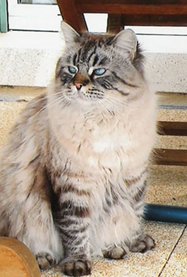
Mitrofan Dikaya Krassa,
SIB n 21 33.
Part 6: The Colourpoint waves
Firstly, speaking of Thai cats, can I remind the readers that there had been no Thai cats as a breed until even later than the Siberians had been recognized? We are talking here of shorthair alley colourpoints. As in any random population, there are different types there. Some can be heavy and large, others elegant and refined. When Thai were being developed as a breed, the source was the random population with medium light boning; however, there were cats with medium heavy and heavy type, and felinologists didn't even dream of using them as Thai! SFF recognized European Shorthair in the cp variety, just because there were plenty of this type shorthair cp cats, too. This, however, didn't find wider recognition, because the European Shorthair was not a breed developed in Russia. So the "Pallas" cp was not a Thai cat... Nor was it a Siamese. It was an alley cat of unknown origin, of sturdy type (look at the boning!) characteristic for Russian aboriginal cats, but of a different color. Being born from a black cat means the presence of the gene in the population in a recessive form. How it got there - is a question that can't be answered at the present level of knowledge. But by being there for such a long time it is no more alien to the population than any other mutation different from the wild black tabby phenotype.
There is nothing to argue about when we talk of the origin of the colourpoint mutation. The chance of an independent mutation away from South-Eastern Asia is quite remote, but this is not relevant. The core of the argument is: How far behind in time must a mutation lie, how far behind in time must it have reached Russia for Dr. Kolesnikov to count it to the aboriginal gene pool? Cats carrying it must have appeared in Russia, besides, early enough to not include the b and bl alleles, which have never been present in those alley colourpoint cats in Russia.
Genetic geography shows that the origin of the classic tabby mutation is on the British Isles. Shall it be considered as un-Russian? It is just one of plentiful examples of how far we can carry the evaluation of what is alien and what is not.
In my humble opinion, a breed developed on the basis of Russian SLH alley cat population can be allowed to possess all genes this population has had by the time when breeding started. I have never seen any reasons for either adding or removing colors. Unless one wants to create something really different from the existing breed, a cat that looks like one of the wild species. In this case, however, not only colors should be different...
The first "wave" of colourpoints has come to Russia centuries before Obrastsov's cats. Moreover, if one considers them to be the cornerstone of the introduction of the cp gene into SLH population, why, then, were they so plentiful in the 80's in St. Petersburg and quite rare in Moscow, where the original pair of Obrastsov's cats had lived? The obvious answer is the more frequent presence of this gene in the recessive form in St. Petersburg. Was it due to the city being a sea port? Then why was the other place of frequent appearance of cp SLH Samara and not Vladivostok? There is some probability that Obrastsov's cats have contributed to the spreading of the gene, but it cannot be the sole reason for this.
What is more, the speed of cat reproduction suggests that not only the first introduction of the cp gene into the Russian cat population had been "diluted" and "digested" by hundreds of generations, but also the re-introduction via Obrastsov's cats lay at least between 12 and 20 generations before Siberian breeding started.
If we speak of colourpoints appearing within the Siberian breed, the real first wave was formed by the alley cats taken out of the street population to start breeding. They differed from their non-cp brothers and sisters only in color.
The "second wave" has taken place not in the way suggested in Dr. Kolesnikov's article, as explained in part 5. If the author means erroneous recognition of several non-pedigree cats as novice Siberians by some uncritical judges, then I do agree - but why should they be regarded as results of Balinese breeding? They were mostly pretty fluffy kittens bought in the market without papers.
The "third wave"... Here I tend to agree with the author. There have always been and will always be attempts to outcross, and we have some results of those attempts in non-cp's as well as in cp's. The thing is that we must join forces to eliminate these results from breeding stock, whatever the color. This can only be done by judging type and coat texture first and foremost.
Part 7: Recessive and dominant color mutations in breeding
I must first mention that silver has been introduced into Siberians in the same way as all other recognized color mutations: by random matings within alley cat populations. It had been there by the time of the start of planned breeding, same as colourpoint. Introducing silver from a different breed would be thus unnecessary, harmful and not allowable by any cat fancy federation. The same concerns purposeful introduction of the cp gene from another breed. This gene, however, has also been there, and also in the most "archetypal" Siberians I have ever seen.
Trying to make out what the real danger of the cp mutation is, I have stumbled on a recommendation showing how to work with dominant traits introduced into the population: explaining that silver can be bred in using one ancestor (which, as I see it, results in steadily increasing inbreeding) and that it is easy to monitor the undesired traits. Did I get it right that the undesired traits seen by the eye are phenotypical features, like type, coat etc.? Then what is the difference between the recommended control and the usual monitoring of the type, coat etc. in all progeny done by all breeders?
Type and color are not related. A dominant color mutation is accompanied by all other genetic traits (present in the cat introduced into breeding) influencing type, coat, health, etc., which can be recessive, dominant, show incomplete penetration or be polygenetic. There is no connection between the ways these traits are inherited. For breeding, a non-silver cat obtained from a heterozygous sire can be as good or as bad in type as any silver cat. It won't be used for breeding silver, but it can be used for breeding other colors. What intermediate progeny should be eliminated? Intermediate phenotype? How can body conformation and coat texture depend on a recessive or dominant nature of the color mutation?
Every breeder monitors the quality of kittens. No breeder can "read" the complete genotype albeit a dominant or a recessive mutation. Where does the danger lie? In the inability of the breeder to see if the acromelanistic gene is carried by a non-cp cat? This can be cared for by a simple test. Or in the inability to understand what traits are going to influence the type? No difference here between a dominant and a recessive color genes. Does anyone believe that if a long-nosed silver cat has been used for breeding, it is easier to eliminate the poor type it produces than if one uses a long-nosed colourpoint cat?
Any time a breeder gets out of his own lines, which is unavoidable if one doesn't want to sink in inbreeding and incest, there is a risk to get an incompatible line and ruin the type. Even if you have been breeding red spotted cats for years and are adding a red spotted from an unrelated line, you might get unexpected poor progeny, which has to be eliminated from breeding.
Does the danger lie in anything harmful genetically linked with the cs gene? We have yet to learn that there exists something like that. Quite improbable, by the way, otherwise the cats bred for ages (Siamese, Birmans, Ragdolls, etc.) would all have been harmfully affected.
What is the reason for the recommendation to control genetically all heterozygous cats from a cp/non-cp mating? To be able to avoid getting cp kittens? Then why use a cp at all?
For me, it is an obscure vicious circle, without any other reason but the conviction that the cp gene is alien... and that's what I have been contradicting for quite a while already. Taste and stereotype thing, actually.
Can I repeat what I said above? Why don't we join forces to promote Siberians with the standard phenotype in all colors instead fighting absolutely anything which differs in opinion?
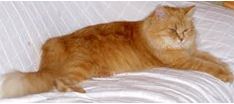 |
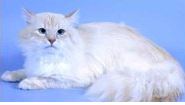 |
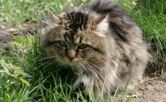 |
| Three generations: | ||
| GICh Alionka Dikaya Krassa | WCh Iz Ermitage Hirdon | Platon Dikaya Krassa |
Answer for the unprejudiced reader:
Cats ## 1, 4, 8 and 10: Black tabby males, colourpoint carriers, with several colourpoint Siberians on the pedigree.
Cats ## 2, 3, 7 and 9: Black tabby males without any colourpoints in the lines.
Cats ## 5 and 6: Seal tabby point males, from colourpoint only lines.
All these cats are Siberian males from different countries with Russian origin, displaying striking similarity and stability of standard type, with broad low set cheekbones, massive muzzles and mild profile lines.
© 2008. Irina Sadovnikova, WCF Int. All Breed Judge.
